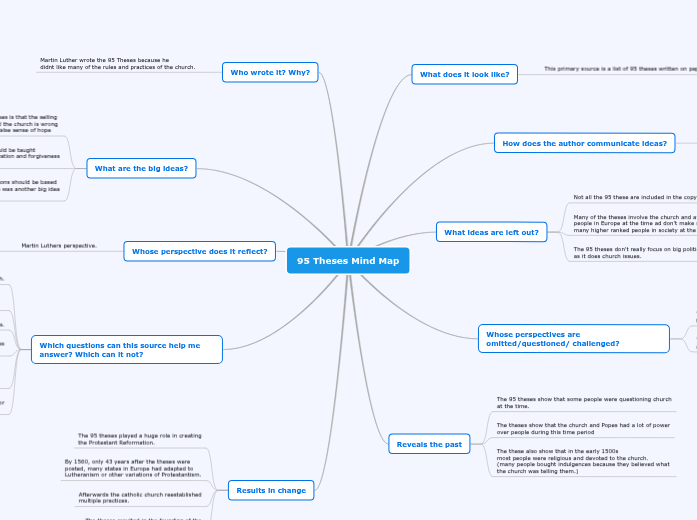95 Theses Mind Map
What does it look like?
This primary source is a list of 95 theses written on paper.
How does the author communicate ideas?
Martin Luther made a list of 95 theses/issues he
had with the church.
What ideas are left out?
Not all the 95 these are included in the copy in our lesson.
Many of the theses involve the church and average/regular
people in Europe at the time ad don't make reference to
many higher ranked people in society at the time.
The 95 theses don't really focus on big political issues as much as it does church issues.
Whose perspectives are omitted/questioned/ challenged?
The church and the Pope are being challenged in
the 95 theses.
The fact that he also nailed the theses to a church doors
can reflect that he is also challenging authorities.
Reveals the past
The 95 theses show that some people were questioning church at the time.
The theses show that the church and Popes had a lot of power
over people during this time period
The these also show that in the early 1500s
most people were religious and devoted to the church.
(many people bought indulgences because they believed what the church was telling them.)
Who wrote it? Why?
Martin Luther wrote the 95 Theses because he
didnt like many of the rules and practices of the church.
What are the big ideas?
One big idea in the 95 theses is that the selling
of indulgences to help fund the church is wrong
because it gives people a false sense of hope
Another big idea was that people should be taught
how to have faith in their God for salvation and forgiveness
in church.
The fact the church lessons should be based
on words from the bible was another big idea
in the 95 theses.
Whose perspective does it reflect?
Martin Luthers perspective.
Martin luther studied theology so he had
a theological perspective.
Which questions can this source help me answer? Which can it not?
The 95 theses tell us why martin luther was angry at church.
They also tell us that there were issues with some church practices.
This document doesn't tell you if or what changed afterwards.
It doesn't tell us what other people thought of church practices or what their responses to the 95 theses were.
It doesn't answer whether there were similar issues or whether this affected church practices in other countries like Spain
It doesn't answer whether the theses were the main or
soul reason for reformation.
Results in change
The 95 theses played a huge role in creating
the Protestant Reformation.
By 1560, only 43 years after the theses were
posted, many states in Europe had adapted to
Lutheranism or other variations of Protestantism.
Afterwards the catholic church reestablished
multiple practices.
The theses resulted in the founding of the
Jesuits.
